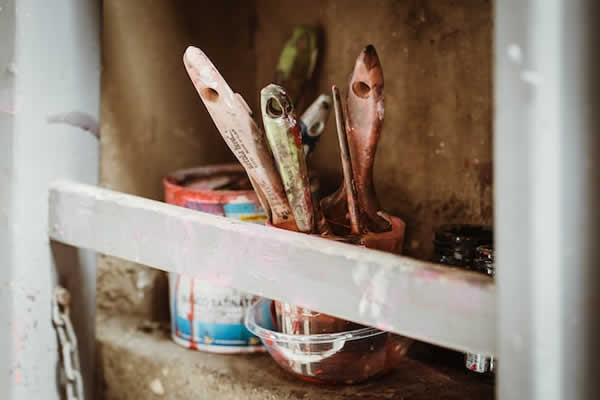Creating a pristine finish on your home's walls is the key to making any room look and feel good. Whether you're redecorating an old bedroom or moving into a new place and then updating the interior décor, wall painting can make all the difference. But, with so many coats of paint and layers of sandpaper, prepping for your perfect paint job can be daunting. That's why we've put together this guide that covers all the essentials – from choosing tools to applying each coat cleanup trick – for achieving flawless results every time you repaint your walls!

Preparing Your Walls for Painting
Before you start painting your home's walls, it's important to make sure that you properly prepare them so that you get a flawless finish. This means understanding the types of sanding, priming, and sealing processes that are required for specific wall surfaces--before applying any paint. Sanding is necessary for removing older paint and ensuring a smooth surface for the new coat. Primer helps create an even base upon which the paint can be applied, and sealing increases the longevity of your painted walls. Taking the time to fully understand these processes can save you from headaches in the long run! When looking for sanding discs for your project, make sure you select the right grit for your wall type. It's also important to use a vacuum and damp cloth to clear away any dust that is created from sanding.
Choosing the Right Paint and Brushes
Painting your home’s walls can be an exciting and creative experience, but it’s essential to choose the right type of paint and brushes to ensure you get a flawless finish. Consider going with an eggshell or satin finish as they are ideal for cleaning and will look beautiful when fully dry. To get smooth coverage on your walls, select brushes that have synthetic bristles—these will move easily in tight corners and along corners. If you’re feeling more ambitious, invest in good-quality roller covers that offer greater control when painting large surfaces. All of these steps will ensure a professional-looking result so you can enjoy your newly painted wall for years to come!
Step-by-Step Guide to Sanding and Painting Your Walls Properly
The key to successfully sanding and painting your walls is having a step-by-step guide. To start, you'll want to prepare the wall surface by scrubbing it to remove residue and blemishes, then properly sand it down for layering your paint. After that, give the wall a good coat of primer and once it dries, go in with the first layer of paint, and don't forget to let each coat dry! Finally, be sure to check for any visible imperfections—you can use fine-grit sandpaper for spot touch-ups and then top off the job with a glossy varnish for an unbeatable finish. With these simple steps in mind, you're guaranteed a reliable and professional look! Try to plan out your painting process in advance to avoid any unnecessary steps that could result in a sloppy finish.
Common Mistakes to Avoid
When it comes to prepping and painting your home's walls, there are several mistakes that many homeowners make without even realizing it. Common errors include failing to adequately clean the surface before sanding, using the wrong grade of sandpaper for the task at hand, and not using clothespins or painter's tape to protect furniture and fixtures around the room. Additionally, a final coat of paint is likely necessary after sanding if you want a flawlessly smooth finish - otherwise, unsightly bumps or ridges in your walls might appear when finished. Avoid these mistakes by understanding the tools and techniques needed to properly sand and paint your walls: they can mean the difference between an amazing result and a botched paint job!
Tips and Tricks for Finishing Up Your Project Faster and Easier
If you're considering updating the look of your home's wall with fresh paint, then don't forget to factor in the prep work too. Sanding and painting can be overwhelming tasks, but there are plenty of tips that can help you finish up your project faster and easier. It all starts with selecting the right supplies: make sure you invest in a good sandpaper for a smoother finish, use two layers of coat for added durability, and include a primer if transitioning from a dark color to light. In addition to giving yourself enough time to complete each step (prep work to drying time), planning ahead will not only help you stay organized but also prevent any potential mistakes or missteps. And when you finally get access to your walls, be sure to use concentrated strokes in the same direction — this ensures an even coating and better coverage per stroke. Remember these tips, and with some patience and practice, you'll have an amazing end result guaranteed!
Maintenance Tips
After you've finished sanding and painting your home's walls, it's important to take steps for maintaining the newly flawless finish. Clean the area regularly with a soft cloth, warm water, and mild dishwashing liquid. This will help keep dust and other airborne particles that can accumulate on the wall surfaces at bay. To prevent damage from occurring, be sure to move furniture around occasionally so it doesn't scrape against the walls or cause accidental paint chips. Lastly, every 2-3 years, make sure to inspect seals in door frames, windowsills, and exterior trim to ensure they are still airtight against drafty weather conditions. By taking these simple steps of maintenance now, you can enjoy your freshly painted walls for years to come!

To sum it up, sanding and painting walls is a complex but rewarding project. Preparing your walls beforehand is important to ensure a flawless finish. The right type of sanding, priming, sealing, paint, and brushes make all the difference in achieving a professional look for your home's walls. Following the step-by-step guide carefully will help you avoid common mistakes like not sanding enough or using an outdated brush. With useful tips and tricks, you'll be able to complete this project faster and easier with amazing results. So roll up your sleeves and get ready to make your home shine with a beautiful new look - courtesy of your sanding and painting skills!
